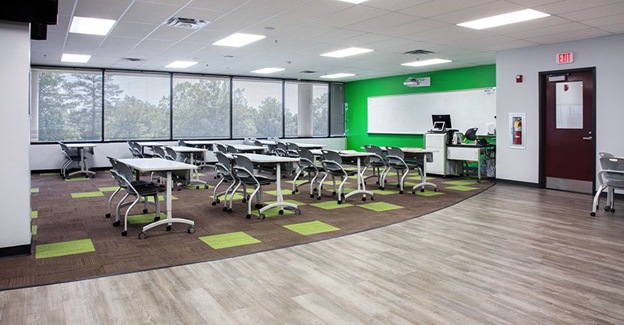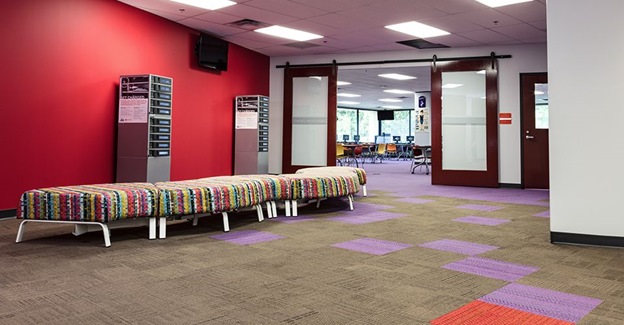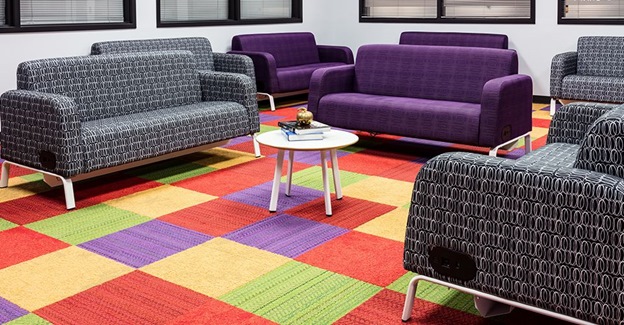One step into THINC College & Career Academy and you know this is a place of innovation. Robotics, science and healthcare labs, collaborative classrooms and even a market space, are all set against a backdrop of vivid colors and patterns. It’s clear this is not your typical high school environment.
Located in LaGrange, Georgia, THINC College & Career Academy combines public and private funds to provide high school students with an authentic workplace curriculum. The academy, which serves students from the three high schools in Troup County, Georgia, is among more than three dozen college and career academies in the state that aim to prepare students for 21st-century careers. Students attend this public charter school for half the school day while they attend their traditional high school for the other half.
Education that gets down to business
Recognizing the need for better prepared workers, Troup County’s Strategic Planning Group explored what other communities were doing for workforce development and discovered that the most successful had college and career academies for high school students. Before moving forward, they did a bit more homework and surveyed local businesses to learn more about their current workers and what their ideal workforce looked like. As Robby Burch, Interface’s director of customer care and THINC board member, puts it, “If the business community built a school, this is how they would do it.”
The THINC academic model is unique, technology-rich and responsive to student and teacher needs. Emphasizing critical thinking with business applications, THINC Academy meshes academic requirements with workforce needs through leading edge technology, flexible classroom space and project-based assignments. The academy includes 14 classrooms that focus on different career paths with additional open areas such as a coffee shop and lobby.
Keeping in step with their focus on innovation and business, the THINC facility has the feel of a Google office with brightly colored carpet tiles, glass walls, modern furniture and collaborative workspaces. While many college and career academies look like a traditional high school, that’s not the case with THINC.
“The whole space breathes this atmosphere of creativity and excitement,” said Ashley Smith of Smith Design Group, the firm that designed the THINC space. “Atmosphere plays a big part in architecture, but that’s often lost in the institutional prototype for education. Most schools have been pushed into this ‘box’ design that can be reproduced easily. We wanted to give this space a fun vibe that would be stimulating for teens, something they would be proud of and that would inspire them to be creative.”
A colorful place to learn
One might think high school students wouldn’t notice design details like the flooring used in their space, but nothing could be farther from the truth. When asked about the Interface modular carpet used at THINC, students in the Spanish and Government classes had plenty to say:
“It’s so much better than boring carpet. The happy, bright colors make us think more.”
“The carpet adds more comfort to the classroom, and it looks cool and inviting.”
“It’s not cold like the hard tile floors in our other high schools. The carpet really warms it up.”
“I like the different abstract patterns, and the vibrant colors wake me up a little bit, especially for those early morning classes.”
Vibrant colors are everywhere at THINC. The hallways are adorned with abstract works of art created by local artists. At your feet there are carpet tiles in 18 different colors, thanks to a donation by Interface. Using a variety of styles and colors on the floor provides a creative, energetic space, helps direct student traffic flow and identifies specific spaces and areas of study.
Design with a purpose
Of course, the school’s innovative design is backed by a very distinct purpose. All furnishings and design choices were carefully selected to align with THINC’s vision to drive a new era of innovation, growth and productivity in Troup County and the surrounding region through cutting-edge education.
Since the school opened its doors in August 2015, students have been working in teams to complete hands-on, authentic projects related to one of five career paths: mechatronics, energy and engineering, marketing, business and healthcare. With students focusing on careers and the school’s 13 “soft skills,” the space needed to reflect an air of professionalism while still inspiring creativity. According to Burch, “Students here are treated like adults and are expected to understand how to regulate what they’d like to do with what they’re expected to do. Thirty percent of their grade is based on ‘soft’ skills – showing up on time, knowing how to collaborate, being respectful – skills that are needed to succeed in a business environment.”
A definite case of form following function, the school’s design was created with its unique curriculum and vision in mind – a design that supports and even promotes out-of-the-box thinking. With the design of these learning spaces, “We’ve created a different perception of what we’re asking kids to do,” said Burch. “It’s not school as they know it.”
About Interface
Interface, Inc. is a global flooring company specializing in carbon neutral carpet tile and resilient flooring, including luxury vinyl tile (LVT) and nora® rubber flooring. We help our customers create high-performance interior spaces that support well-being, productivity, and creativity, as well as the sustainability of the planet. Our mission, Climate Take Back™, invites you to join us as we commit to operating in a way that is restorative to the planet and creates a climate fit for life.
Learn more about Interface at interface.com and blog.interface.com.



